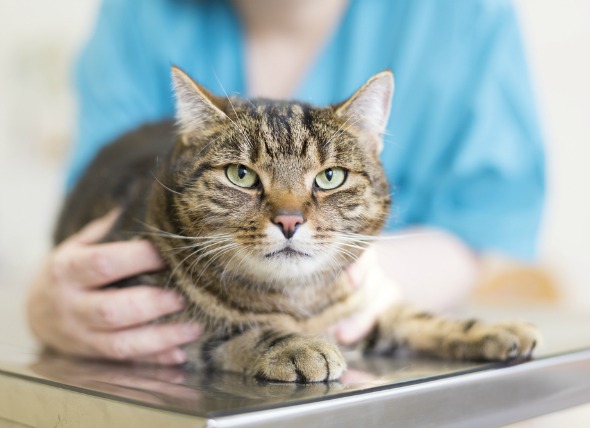
You’re almost there - soon you’ll get to pick up your new kitty! You did the research and you found the perfect one. Now it is time for them to move in with you and come home. It is officially time to roll out the welcome wagon.
What could you put in that welcome wagon? Well, there are the basic things - food bowls, water bowl or fountain, litter trays, scratching posts, sleeping spots and of course toys. But if you truly want to help your kitty feel at home, I’m going to suggest the following steps.
 First off, set up a small room in your home that is quiet - so try to avoid using the laundry room. This will be your kitty’s sanctuary for the next few days - perhaps a week. Of course, you want your new companion to see the entire house but that can be quite overwhelming. Remember, your kitty does not know what is happening - all they know is that they are being removed from their familiar territory and stuffed in a box to go…god only knows where. They have no way of knowing if they’ll be safe, if the natives will be hostile and what will happen to them. Moving is actually incredibly stressful for a cat. So, take it slow and give them time to digest the shock of it all. Give them a small room that is easy to scout, and become familiar with with everything they need right there. Once they’ve gained their bearings, you can take it to the next level. Also, if you can - wait to take them to the vet until they are fully acclimatised so to not overwhelm them with stressful experiences.
First off, set up a small room in your home that is quiet - so try to avoid using the laundry room. This will be your kitty’s sanctuary for the next few days - perhaps a week. Of course, you want your new companion to see the entire house but that can be quite overwhelming. Remember, your kitty does not know what is happening - all they know is that they are being removed from their familiar territory and stuffed in a box to go…god only knows where. They have no way of knowing if they’ll be safe, if the natives will be hostile and what will happen to them. Moving is actually incredibly stressful for a cat. So, take it slow and give them time to digest the shock of it all. Give them a small room that is easy to scout, and become familiar with with everything they need right there. Once they’ve gained their bearings, you can take it to the next level. Also, if you can - wait to take them to the vet until they are fully acclimatised so to not overwhelm them with stressful experiences.
Set up the room with a food bowl that is properly distanced from a water bowl to prevent contamination. Consider making the water bowl topple-proof as some cats can’t resist experimenting. On the other side of the room, set up the litter tray. Just as we don’t enjoy eating while in the bathroom, they too prefer those two areas to be separated. If the room is relatively barren, add some carton boxes or furniture that the cat can hide in or under - this will be their first instinct to make themselves feel safe when they arrive. A nice touch is to put a small scratching pad or post near the door, so they can mark it with their own scent. Doors tend to be the place through which foreign smells enter, so it is reassuring to have a place to reinforce your own scent.
Lastly, consider using a Feliway spray to mark the corners of the room half an hour before you pick up the cat, to truly make them feel as comfortable as possible. It mimics their own facial marking pheromones - the kind they use to mark territory that they feel fairly comfortable in. You could use their diffuser as well but it might be too overbearing for a small room as they are intended for larger spaces. Plus, that spray will come in handy later on as well.

Next, contact the place your kitty is staying at and ask them to put aside some of the food and litter they use - as well as a blanket that has the cat’s smell in it, if they have it. Alternatively, get the names of the brands for the litter and food. With all the changes that your cat will go through, they don’t need the hassle of dealing with an upset stomach that is getting used to a new type of food as well. Meanwhile, having their familiar litter available will minimise the risk of your new cat selecting another spot in the room to do their business.
If you afterwards want to move them over to other litter and other food, you can. Just mix the old food with the new food - first 3/4 old food, 1/4 new, then half and half, and then 3/4 new and 1/4 old, before fully moving over. Spread the process out over a week. You can use the same trick with the litter, or you can just offer them another litter box with the new litter and see how they take to it. But these are things best left until after your kitty has settled in.
Then there is the trip home - this is where the blanket comes in. First, spray the insides of your pet carrier with the Feliway spray if you have one, then put the blanket you asked for in the pet carrier once you arrive there. This will ensure that the animal has at least something familiar and soothing the help them through the stress of the transport.
When you finally get your kitty home, bring them straight to the safe room. It will be tempting to greet the cat and introduce them to the family but save that for a little later. Put the pet carrier in the room, and open it. Then leave. Yes, pull that door closed behind you. You can stay in the adjacent room to keep an ear on things, if you like. See, right now, that cat has enough to deal with without having to deal with people. Their first priority will be getting to know their new surroundings and establishing some kind of safe ground.
Feel free to check up on them after an hour - half an hour or even 15 minutes for kittens. What you re looking for is a cat that is curious to come up to you. If the cat is still hiding or still in their pet carrier, leave again and give them some more time. First though, check if they’ve eaten or used the litter tray first though as those tend to indicate that the cat has at least gotten somewhat comfortable. Furthermore, a cat needs to use both within two days or you might have a problem that requires a vet.
 If they aren’t in hiding and are taking you in, feel free to sit down - just don’t stare at them. Let them come to you at their own time. This may take some time - days even - or happen within that hour, but if they come up to you, preferably with their tail up, you’re good. Once you have a tail up, food is being eaten and the litter is being used, your cat is ready to meet the rest of the family - one at a time. If you have other cats in the house, you may want to check out how to introduce them properly before opening the door to the sanctuary.
If they aren’t in hiding and are taking you in, feel free to sit down - just don’t stare at them. Let them come to you at their own time. This may take some time - days even - or happen within that hour, but if they come up to you, preferably with their tail up, you’re good. Once you have a tail up, food is being eaten and the litter is being used, your cat is ready to meet the rest of the family - one at a time. If you have other cats in the house, you may want to check out how to introduce them properly before opening the door to the sanctuary.
After that, it is time to show them the rest of your house. Open the door to the safe room, and leave it open. Your cat will likely scout a part of the house, then retreat back to their room if they feel overwhelmed. Let them do this at their own pace and don’t distract them during this process. Before long, you’ll see them strutting their stuff in their new digs, removing the need for a safe room entirely. Look once again for that tail-up as confirmation.
Similarly, if you are planning to let kitty go outdoors - give them a chance to explore the outdoors with the door open, so they can run back inside when need be. Keep in mind though that it is best to wait 4 to 6 weeks before you let your cat outside, in order to make sure that they consider your home theirs. That way, you’re sure they’ll find their way back home.
Congratulations on your new furry companion!
 Lungworms in Cats
Parasitic Respiratory Infections in Cats
Lungworm
Lungworms in Cats
Parasitic Respiratory Infections in Cats
Lungworm
 Intestinal Parasite (Coccidia) in Cats
Coccidiosis in Cats
Coccidiosis is a parasitic ty
Intestinal Parasite (Coccidia) in Cats
Coccidiosis in Cats
Coccidiosis is a parasitic ty
 Blood in the Front of the Eye in Cats
Hyphema in Cats
Hyphema, or blood in the anterior
Blood in the Front of the Eye in Cats
Hyphema in Cats
Hyphema, or blood in the anterior
 Abnormal Eyelid in Cats
Entropion in Cats
Entropion is a genetic conditio
Abnormal Eyelid in Cats
Entropion in Cats
Entropion is a genetic conditio
 Sleek Cat Tree Suits Modern Cozy Places
Felines Love (and Need) to Climb
Cred
Sleek Cat Tree Suits Modern Cozy Places
Felines Love (and Need) to Climb
Cred
Copyright © 2005-2016 Pet Information All Rights Reserved
Contact us: www162date@outlook.com